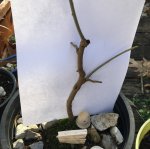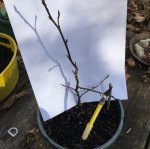all your trees have a bit of growing to do, but all, with time could become good bonsai. Do you have a specific question you need help with?
If your collection was mine, all would be in nursery or grow boxes or Anderson flats, you need to thicken those trunks. I too think the willow oak has potential, but it is the one with the largest diameter trunk.
The one listed as gum or maple has a nice pattern of buds on the trunk, the buds are in an alternate pattern, it can not be a maple, as all maples have buds opposite to each other at each node. The tupelo have alternate leaf pattern. The bud pattern suggests a tree that will be relatively easy to train as bonsai once you get the diameter of the trunk up to size. If it is black gum aka black tupelo, Nyssa sylvatica, they make excellent bonsai, famous for brilliant autumn colors. If it is water tupelo, or tupelo gum - Nyssa aquatica - it also has been used for bonsai, though its leaves are a bit larger than Nyssa sylvatica. N.aquatica tends to develop a wide, fluted base, much like a bald cypress, and lives in bald cypress swamps. If it is something else, it might still be good for bonsai. All Nyssa develop a rough alligator checked bark with age.
The chinese tallow tree -
Triadica sebifera - is an invasive species. Nothing wrong with using it for bonsai, in fact, getting these out of the landscape into a pot where it is less likely to spread seed is a ''good thing''. It is very fast growing, may be hard to keep on top of. Leaves tend to be large, but developing multiple levels of branch ramification will bring leaf size down. Looks like it will bud back easily, making the use of grow out then chop back hard a ''go to'' technique. I have seen photos of this as penjing, from Taiwan or China. I think they were pretty good sized trees, over 2 feet tall (>0.6 meters) I will be curious to see how it develops. Because it grows fast, you can probably get the trunk up to a useable diameter in 3 years or so. Warning, tallow trees secrete toxins that kill off competing vegetation, don't try to use it in a mixed species forest planting, or you will end up with just tallow trees in your forest planting. (much like walnut)
Even for the smallest of bonsai, you want trunks larger than 1 inch (> 2.5 cm) in diameter. Better, even for small bonsai is a trunk over 2 inches (> 5 cm). This would be for a tree less than 8 inches tall when finally ready for display. Medium size bonsai trunk should be over 2 inches, to 4 inches in diameter, or larger in more extreme examples. (4 inches is roughly 10 cm) Bonsai over 24 inches tall need trunks well over 4 inches in diameter for most designs.
This means that all these trees, in order to get these larger diameter trunks will need to be grown out to fairly larger size, as a whip, to 6 feet tall or taller, or be forced to bush out, like a hedge. Diameter of trunk is determined mainly by the total amount of foliage the bush or tree supports.
But all the trees you have posted have potential, after growing out for 5 to 10 years depending on what the final size of the bonsai you want to have. Grow them for fat trunks. Keep them in nursery size grow pots for a while.
Good reference articles on growing pre-bonsai can be found here
http://www.evergreengardenworks.com/articles.htm
 chinese tallow
chinese tallow 





![IMG_0144[1].JPG IMG_0144[1].JPG](https://www.bonsainut.com/data/attachments/116/116384-b8df7880d8ac30a4e7f5bdca715e844c.jpg)
![IMG_0145[1].JPG IMG_0145[1].JPG](https://www.bonsainut.com/data/attachments/116/116385-7b201d8e2eb4324fe38028ea3c0efa87.jpg)
![IMG_0146[1].JPG IMG_0146[1].JPG](https://www.bonsainut.com/data/attachments/116/116390-689c307ecc7e5d83246767b9e59b816e.jpg)
![IMG_0149[1].JPG IMG_0149[1].JPG](https://www.bonsainut.com/data/attachments/116/116391-8a158610ee32622b0d25abcb83871144.jpg)